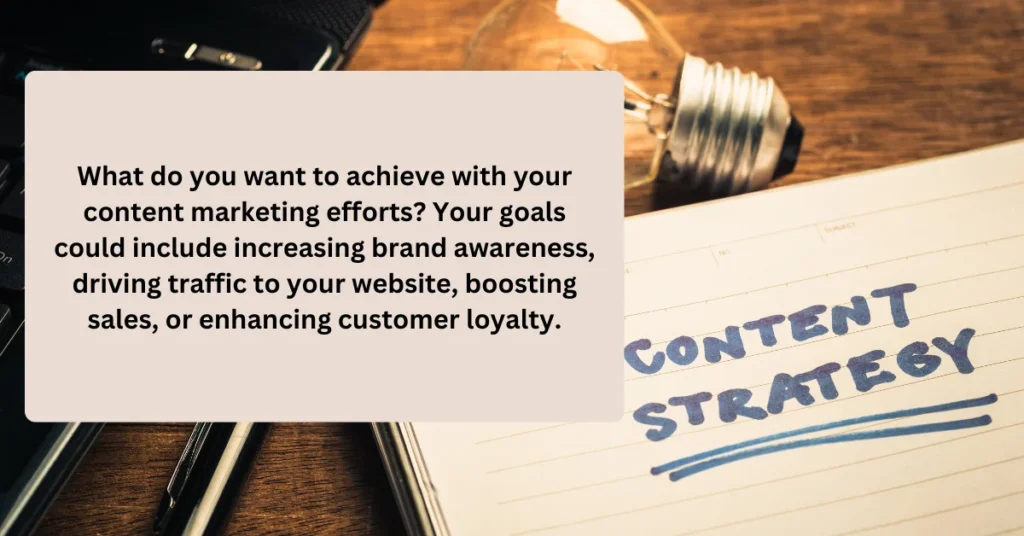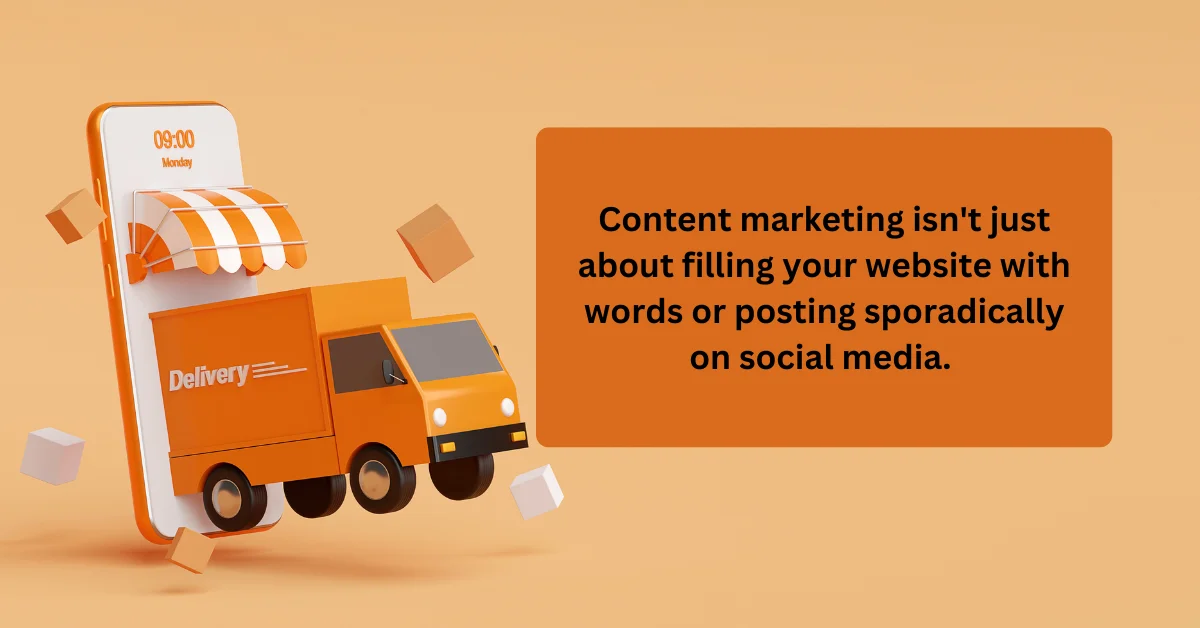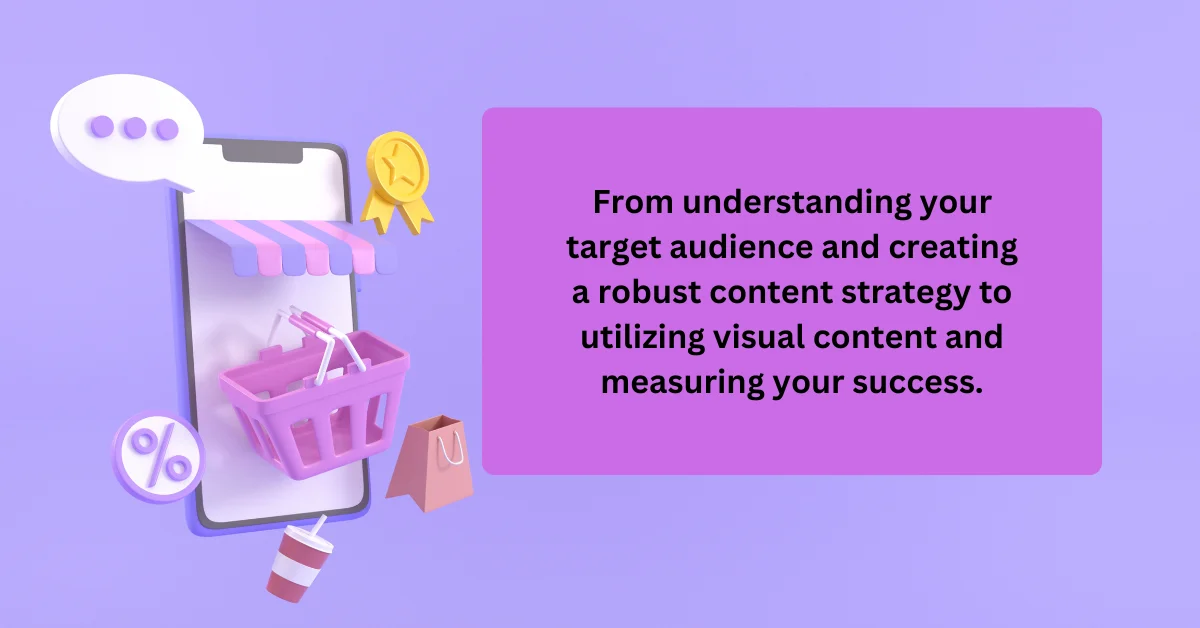In the ever-evolving world of e-commerce, content is more than just king—it’s the key to unlocking sales and building lasting relationships with customers. The digital marketplace is crowded, with countless brands vying for the attention of consumers. So, how can your e-commerce business stand out? The answer lies in creating content that not only captures interest but also drives conversions.
Content marketing isn’t just about filling your website with words or posting sporadically on social media. It’s about crafting a strategic narrative that speaks directly to your audience, addressing their needs, solving their problems, and ultimately, compelling them to click “Buy Now.”
This guide will walk you through the essential steps of creating content that converts, from understanding your target audience and selecting the right types of content to crafting a powerful content strategy and promoting it effectively. By the end of this guide, you’ll be equipped with the knowledge to turn your e-commerce content into a powerful sales tool, increasing engagement, building trust, and boosting your bottom line.
Are you ready to dive in? Let’s start by understanding the foundation of all great content—your target audience.
Section 1: Understanding Your Target Audience

Creating content that converts starts with a deep understanding of who you’re speaking to. Without a clear picture of your target audience, your content is like a message in a bottle—adrift in the vast ocean of the internet, hoping to find the right shores. Identifying your ideal customer is crucial because it informs every aspect of your content strategy, from the tone and style of your writing to the types of content you produce and the platforms you use to distribute it.
Identify Your Ideal Customer
Begin by defining your ideal customer. Who are they? What are their demographics, such as age, gender, location, and income level? What are their interests and hobbies? More importantly, what are their needs, pain points, and desires? Developing detailed buyer personas helps you visualize your customers as real people, which in turn allows you to create content that resonates with them on a personal level.
Research Customer Pain Points and Preferences
Understanding what keeps your customers up at night is key to creating content that grabs their attention and keeps them coming back for more. Conduct thorough research to uncover the challenges and pain points your audience faces. Use surveys, customer feedback, social media listening, and analytics tools to gather insights into what your audience cares about most.
For instance, if you run an online store selling eco-friendly products, your customers might be concerned about sustainability and the environmental impact of their purchases. Knowing this, you can create content that addresses these concerns, such as blog posts on how to live a zero-waste lifestyle or videos showcasing the eco-friendly practices of your brand.
Segment Your Audience
Not all customers are created equal. Within your broader target audience, there will be different segments with unique characteristics and preferences. For example, a fashion e-commerce store might have segments for trend-savvy teens, busy professionals, and eco-conscious shoppers. Each of these groups requires different messaging and content types to appeal to their specific needs and interests.
Segmenting your audience allows you to create more personalized and relevant content, which can significantly increase engagement and conversion rates. Use data from your customer research to divide your audience into distinct groups and tailor your content strategy accordingly.
By understanding who your target audience is, what they care about, and how they interact with your brand, you lay the foundation for creating compelling content that not only attracts but also converts. In the next section, we’ll explore the different types of content that can drive sales and keep your audience engaged.
Section 2: Types of Content That Drive Sales
In the realm of e-commerce, not all content is created equal. Some types of content are better at capturing attention, building trust, and persuading customers to make a purchase. To maximize your content marketing efforts, it’s essential to understand which types of content resonate most with your audience and how to use them effectively to drive sales.

Product Descriptions
Product descriptions are more than just lists of features—they are your opportunity to persuade potential buyers that your product is exactly what they need. A well-crafted product description should not only inform but also inspire. It should paint a vivid picture of how the product will solve a problem or improve the customer’s life.
To write engaging and persuasive product descriptions, focus on benefits over features. Instead of simply stating what the product is, describe how it will make the customer feel or the specific problem it will solve. Use sensory language and storytelling to create an emotional connection. For example, rather than saying a sweater is “made of wool,” describe it as “a cozy, soft embrace that keeps you warm on the chilliest of days.”
Blog Posts and Articles
Blogs and articles are powerful tools for driving organic traffic to your site and educating potential customers about your products. By creating valuable, informative content that addresses common questions or provides useful tips, you can position your brand as an authority in your industry and build trust with your audience.
Consider writing how-to guides, product comparisons, and buying guides that help customers make informed purchasing decisions. For instance, a skincare e-commerce store could create a blog post titled “The Ultimate Guide to Choosing the Right Moisturizer for Your Skin Type.” This not only provides valuable information but also subtly promotes the store’s range of moisturizers.
User-Generated Content
User-generated content (UGC) is one of the most authentic and influential types of content you can leverage. Reviews, testimonials, and customer photos serve as social proof, showing potential buyers that real people have purchased and enjoyed your products. Encouraging satisfied customers to share their experiences can help build credibility and trust, making it easier for new customers to make a purchase decision.
To effectively use UGC, showcase customer reviews and photos prominently on your product pages and social media channels. Consider creating a branded hashtag and encouraging customers to share their photos with it. Not only does this provide you with fresh content, but it also fosters a sense of community and engagement among your customers.
Video Content
Video content is a versatile and highly engaging format that can be used in numerous ways to drive sales. Product videos, tutorials, unboxings, and behind-the-scenes content can help bring your products to life and give customers a closer look at what you have to offer.
For example, a clothing e-commerce store might create styling videos showing different ways to wear a new collection, while a tech retailer could produce in-depth tutorials demonstrating how to use their products. Videos are particularly effective because they combine visual and auditory elements, making it easier for viewers to absorb information and remember your brand.
By strategically using different types of content, you can engage your audience at various stages of the buyer’s journey and guide them towards making a purchase. In the next section, we’ll dive into how to craft a comprehensive content strategy that aligns with your business goals and maximizes your e-commerce success.
Section 3: Crafting a Content Strategy for E-commerce
A well-thought-out content strategy is essential for any e-commerce business looking to leverage content marketing effectively. A solid strategy provides direction, ensures consistency, and helps you achieve your business goals. In this section, we will discuss the key components of a successful e-commerce content strategy.

Set Clear Goals
The first step in crafting your content strategy is to set clear, measurable goals. What do you want to achieve with your content marketing efforts? Your goals could include increasing brand awareness, driving traffic to your website, boosting sales, or enhancing customer loyalty.
Defining your objectives will help you tailor your content to meet these goals and provide a benchmark for measuring success. For instance, if your primary goal is to increase sales, your content should focus on highlighting product benefits, showcasing customer testimonials, and creating urgency through limited-time offers.
Content Calendar
Once you’ve set your goals, the next step is to plan and organize your content using a content calendar. A content calendar helps you stay consistent with your content marketing efforts, ensuring that you regularly produce and publish high-quality content that aligns with your business objectives.
Your content calendar should include the type of content you plan to create (e.g., blog posts, videos, social media posts), the topics you want to cover, the target audience for each piece, and the publishing schedule. This level of organization allows you to strategically plan your content around important dates, holidays, or promotional events, maximizing its impact.
SEO Optimization
Search Engine Optimization (SEO) is a critical component of any e-commerce content strategy. By optimizing your content for search engines, you can increase your website’s visibility, attract more organic traffic, and ultimately drive more sales.
To optimize your content for SEO, focus on the following:
- Keyword Research: Identify relevant keywords and phrases that your target audience is searching for and incorporate them naturally into your content.
- On-Page SEO: Optimize your headlines, meta descriptions, image alt text, and internal links to improve your search engine rankings.
- High-Quality Content: Create valuable, informative, and engaging content that addresses the needs and interests of your audience. Search engines prioritize content that provides a good user experience and answers users’ questions.
By setting clear goals, organizing your content with a calendar, and optimizing for SEO, you can create a robust content strategy that drives traffic and conversions. In the next section, we’ll explore the art of writing compelling content that sells, diving into persuasive techniques and best practices to enhance your e-commerce content.
Section 4: Writing Compelling Content That Sells
Crafting compelling content is an art that requires a blend of creativity, psychology, and strategy. For e-commerce businesses, the goal is to create content that not only informs but also persuades readers to make a purchase. Let’s explore some key techniques to help you write content that converts casual browsers into loyal customers.

Use Persuasive Language
The words you choose can have a powerful impact on how your audience perceives your products and your brand. Persuasive language is about tapping into the emotions, desires, and motivations of your readers. It’s about using words that evoke a sense of urgency, excitement, or curiosity.
Here are some tips for using persuasive language in your e-commerce content:
- Power Words: Incorporate power words like “exclusive,” “limited,” “guaranteed,” “free,” and “proven” to create a sense of value and urgency.
- Storytelling: Weave stories into your content to make it more relatable and memorable. Share customer success stories, describe the journey of how your product was created, or tell a story that aligns with your brand values.
- Questions: Use questions to engage readers and encourage them to think about their needs and how your product can fulfill them. For example, “Tired of cold, sleepless nights? Our thermal blankets provide unmatched warmth and comfort.”
Focus on Benefits, Not Just Features
One common mistake in e-commerce content writing is focusing too much on the features of a product rather than its benefits. While features are important, they don’t always communicate the value of the product to the customer. Instead, focus on the benefits—how the product will make the customer’s life better.
For example, instead of saying, “This blender has a 1200-watt motor,” emphasize the benefit: “This powerful blender can effortlessly crush ice and blend your favorite smoothies in seconds, saving you time in the kitchen.” By highlighting benefits, you create a more compelling narrative that resonates with your audience.
Create Urgency and Scarcity
Urgency and scarcity are psychological triggers that can significantly boost your conversion rates. By creating a sense of urgency, you encourage customers to take immediate action, while scarcity implies that the product is in limited supply, making it more desirable.
Here are some ways to create urgency and scarcity in your content:
- Time-Limited Offers: Promote sales or discounts that are only available for a short period. Use phrases like “Today Only,” “Ends Soon,” or “Limited Time Offer.”
- Limited Stock Notifications: Let customers know when an item is almost out of stock with messages like “Only 3 left in stock!” or “Selling Fast!”
- Exclusive Access: Offer exclusive deals or early access to new products for email subscribers or loyalty program members.
By using persuasive language, focusing on benefits, and creating urgency and scarcity, you can craft compelling content that drives sales and keeps customers coming back for more. In the next section, we’ll discuss how to effectively promote your content to reach a wider audience and maximize its impact.
Section 5: Promoting Your Content Effectively
Creating great content is just the first step. To ensure your content reaches your target audience and drives sales, you need a solid promotion strategy. Effective content promotion amplifies your message, increases visibility, and encourages engagement from potential customers. Here are some key strategies to help you promote your e-commerce content effectively.

Social Media Marketing
Social media platforms are powerful tools for promoting your content and connecting with your audience. By sharing your content on platforms like Facebook, Instagram, Twitter, LinkedIn, and Pinterest, you can reach a larger audience and drive more traffic to your website.
Tips for Social Media Promotion:
- Tailor Content to Each Platform: Different social media platforms have unique audiences and content formats. Tailor your content to fit the platform’s style and user preferences. For example, use high-quality images and short, catchy captions on Instagram, while sharing more in-depth articles and updates on LinkedIn.
- Use Hashtags Strategically: Hashtags can help your content get discovered by users interested in specific topics. Use relevant hashtags to increase the visibility of your posts and attract more followers.
- Engage with Your Audience: Social media is a two-way street. Engage with your followers by responding to comments, asking questions, and encouraging user-generated content. This builds a sense of community and fosters customer loyalty.
Email Marketing
Email marketing remains one of the most effective ways to promote your content and nurture relationships with your customers. By sending targeted emails to your subscribers, you can keep them informed about new products, promotions, and valuable content.
Tips for Email Marketing:
- Segment Your Email List: Divide your email list into segments based on customer behavior, preferences, and demographics. This allows you to send more personalized and relevant content to each group, increasing engagement and conversion rates.
- Craft Compelling Subject Lines: The subject line is the first thing your subscribers see, so make it count. Use attention-grabbing phrases, ask questions, or create a sense of urgency to encourage opens.
- Include Clear CTAs: Every email should have a clear call-to-action (CTA) that tells the reader what you want them to do next, whether it’s reading a blog post, watching a video, or making a purchase.
Influencer Collaborations
Influencer marketing is a powerful way to expand your reach and build credibility. By partnering with influencers who align with your brand values and have a strong following in your niche, you can leverage their audience to promote your content.
Tips for Influencer Collaborations:
- Choose the Right Influencers: Look for influencers who have a genuine connection with their audience and a high level of engagement. Micro-influencers, who have smaller but more dedicated followings, can be particularly effective for niche products.
- Create Authentic Partnerships: Collaborate with influencers to create authentic, engaging content that resonates with their followers. This could include product reviews, tutorials, or sponsored posts that highlight your brand’s unique selling points.
- Track Performance: Measure the success of your influencer campaigns by tracking metrics like engagement, reach, and conversions. This data will help you refine your strategy and choose the most effective influencers for future collaborations.
By using social media, email marketing, and influencer collaborations, you can effectively promote your content, increase brand awareness, and drive more sales. In the next section, we’ll explore how to measure the effectiveness of your content marketing efforts and make data-driven decisions to improve your strategy.
Section 6: Measuring Content Effectiveness
Creating and promoting content is a vital part of e-commerce success, but how do you know if your efforts are truly paying off? Measuring the effectiveness of your content marketing strategy is essential for understanding what works, what doesn’t, and how to optimize your approach for better results. Let’s explore the key metrics to track and the tools that can help you evaluate your content’s performance.

Key Metrics to Track
To determine the success of your content marketing efforts, it’s important to track specific metrics that align with your goals. Here are some key performance indicators (KPIs) to consider:
- Traffic: The number of visitors to your website from your content is a fundamental metric. It helps you gauge the reach and visibility of your content. Tools like Google Analytics can provide detailed insights into traffic sources, showing you which content pieces are driving the most visitors.
- Engagement: Engagement metrics, such as time spent on a page, bounce rate, and social shares, help you understand how users are interacting with your content. High engagement indicates that your content is resonating with your audience and keeping them interested.
- Conversion Rates: Conversion rate is one of the most critical metrics for e-commerce. It measures the percentage of visitors who take a desired action, such as making a purchase, signing up for a newsletter, or downloading a resource. By analyzing conversion rates, you can identify which content pieces are most effective at driving sales and other actions.
- ROI (Return on Investment): ROI measures the profitability of your content marketing efforts. It compares the revenue generated from your content to the costs of creating and promoting it. A positive ROI indicates that your content marketing strategy is contributing to your bottom line.
Tools for Analysis
Several tools can help you measure the effectiveness of your content and gain valuable insights:
- Google Analytics: This powerful tool provides comprehensive data on website traffic, user behavior, and conversion rates. You can use Google Analytics to track the performance of individual content pieces, analyze audience demographics, and measure the impact of your content marketing campaigns.
- Social Media Insights: Most social media platforms offer analytics tools that provide insights into how your content is performing. These tools can show you engagement metrics like likes, shares, comments, and reach, helping you understand which posts are resonating with your audience.
- Heatmaps: Heatmap tools, such as Hotjar or Crazy Egg, allow you to see how visitors are interacting with your website. They show you where users are clicking, scrolling, and spending the most time, providing valuable insights into how they engage with your content.
Iterating and Improving
Measuring content effectiveness isn’t just about gathering data—it’s about using that data to make informed decisions and continuously improve your content strategy. Regularly review your metrics to identify trends and patterns. What types of content are performing well? Which pieces are underperforming, and why?
Use these insights to refine your content strategy, experiment with new formats and topics, and optimize your promotion efforts. Remember, content marketing is an ongoing process that requires constant adaptation and innovation to stay ahead of the competition.
By tracking the right metrics and using data to drive your decisions, you can ensure that your content marketing efforts are effective and aligned with your e-commerce goals.
Conclusion
Content marketing for e-commerce is more than just a trend—it’s a critical component of building a successful online business. By understanding your target audience, creating engaging content, and promoting it effectively, you can drive traffic, increase conversions, and build lasting relationships with your customers.
Remember, the key to successful content marketing is not just about quantity but quality. Focus on crafting compelling content that addresses the needs and desires of your audience. Use persuasive language, highlight the benefits of your products, and create a sense of urgency to encourage immediate action.
Additionally, a well-planned content strategy, supported by regular measurement and analysis, will help you stay on track and continuously improve your efforts. By leveraging data-driven insights, you can refine your strategy, enhance your content, and maximize your return on investment.
Now, it’s time to put these strategies into action. Start creating content that not only attracts but also converts, turning casual visitors into loyal customers and driving growth for your e-commerce business.













